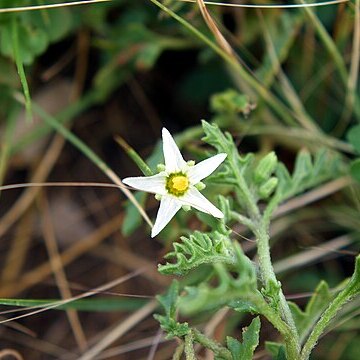Pubescent, annual herb, aromatic, up to 0.75 m high, hairs spreading, up to 2 mm long, viscid, glandular-headed. Leaves ovate, up to 110 x 80 mm, base ± unequal, attenuate to petiole, margins sinuate-dentate; petioles up to 35 mm long. Inflorescence 3-5-flowered umbellate cymes; peduncle up to 25 mm in fruit; pedicels reflexed, up to 10 mm long. Calyx campanulate, up to 6 mm long, lobes ± triangular, up to 5 mm long; enlarged in fruit up to 8 mm long, later reflexed. Corolla ± pentagonal, 10-15 mm in diam., lobes broadly triangular, mainly white. Flowering time Mar. Fruit globose, up to 9 mm in diam., pale green, shiny, later dull, opaque, inside papery calyx; stone grains 4-6, ± 1 mm wide. Seeds many, flattened, pale yellow, up to 1.5 mm long.
Much like no. 2 [Solanum nigrum L.]; stem softly spreading-hairy, the hairs flattened, viscid, often gland-tipped; lvs evidently hairy along the main veins beneath, sometimes over the surfaces as well; cal viscid hairy, accrescent, at maturity 4–6(–9) mm and cupping the lower half of the greenish or yellowish fr, the lobes evidently connate below; 2n=24. A weed in disturbed habitats, native to S. Amer., now widely intr. elsewhere in the world, and sometimes found in our range. Recent work suggests that the name S. sarrachoides should be restricted to a S. Amer. sp. with even more accrescent cal. Our plants would then take the name S. physalifolium Rusby.
Sprawling annual herb to 50 cm, pale green to dark green, pubescent with glandular hairs; prickles absent. Leaves ovate, the lamina to 6 cm long, commonly c. 3 cm, 2–4 cm wide, slightly discolorous, entire or shallowly lobed; petiole 5–15 mm long. Inflorescence short, 2–7–flowered; peduncle 1 cm long; pedicels 5–7 mm long. Calyx 1.5–2.5 mm long, enlarged in fruit; lobes narrowly triangular, 1–2 mm long. Corolla stellate, 12–14 mm diam., white. Anthers 1.5–2 mm long. Berry globular, 5–8 mm diam., green to purplish-green when ripe. Seeds 1.8–2 mm long, light brown. Stone-cell granules 0.5–0.8 mm diam.

